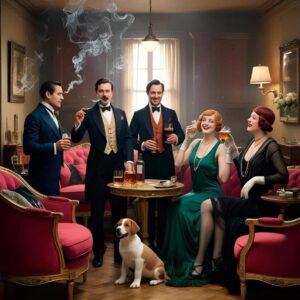Chapter 2 of F. Scott Fitzgerald’s The Great Gatsby pulls narrator Nick Carraway from Long Island’s refined estates into jarringly different territories.
First, the chapter drags Nick to the grim industrial wasteland known as the “valley of ashes,” then to a sordid, chaotic apartment party in New York City.
We explore the chapter’s potent symbolism, sharp character revelations, critique of Jazz Age morality, and Nick’s complicated journey into these uncomfortable truths. For a factual recap, see the Chapter 2 Summary.
The Valley of Ashes: Landscape of Consequences
Fitzgerald establishes the valley of ashes as more than a setting; it symbolizes industrial fallout and spiritual emptiness. It’s a “fantastic farm where ashes grow like wheat,” choked by the city’s refuse. Bounded by a “small foul river,” its bleakness becomes inescapable; train delays at the drawbridge force passengers into prolonged observation of this wasteland.
This landscape physically manifests the decay from unchecked materialism, trapping inhabitants like George Wilson in its grey dust.
Eckleburg’s Gaze: Faded Judgment
The Eyes of Doctor T. J. Eckleburg—”blue and gigantic” behind “enormous yellow spectacles”—dominate the valley from a decaying billboard. Detached from any face, these commercial remnants possess potent, ambiguous symbolism. As literal advertising, they evoke a world where commerce perhaps mimics or replaces divine oversight.
Their persistent, brooding gaze over the “solemn dumping ground” suggests judgment. Yet, their faded state hints this vigilance might be hollow or decaying, reflecting a world losing its moral compass.
Encounters in the Dust: Class and Character Revealed
The garage encounter exposes characters stripped of social pretense. George Wilson, “blond, spiritless man, anaemic,” physically veiled in ash, embodies the valley’s defeated potential. His hopeful inquiry about the car Tom dangles before him meets only condescending delays, demonstrating his vulnerability to Tom’s manipulation.
Myrtle Wilson erupts with a “palpable vitality” against the garage’s gloom. Her complete dismissal of George—striding through him “as if he were a ghost”—reveals her intense focus on Tom as her escape vehicle.
As George dutifully fetches chairs at her request, Tom seizes the moment for their furtive arrangement: “Get on the next train… I’ll meet you by the news-stand on the lower level.” Her nod seals the plan.
Tom’s actions solidify his character. Bolstered by alcohol, he compels Nick’s presence, his determination “bordering on violence”—much like the drawbridge forces commuters to observe, Tom forces Nick to witness his transgression. Waiting later for Myrtle, Tom scorns Wilson’s ignorance (“He’s so dumb he doesn’t know he’s alive”), revealing his callous class arrogance.

Performing Status: The Apartment’s Hollow Stage
The stifling Morningside Heights apartment becomes a stage for Myrtle’s desperate performance of upper-class life. The small rooms crammed with oversized, gilded furniture depicting Versailles scenes highlight the artificiality of her aspirations.
Myrtle transforms with her cream chiffon dress, adopting an “impressive hauteur.” She surrounds herself with props like gossip magazines (Town Tattle) and the new puppy, which is quickly neglected, its biscuit left “decomposing apathetically,” hinting at the disposability of her affections and perhaps Tom’s view of her.
She holds court, attempting to assert status over her sister Catherine and the fawning McKees. She complains loudly about servants and the cost of a foot doctor, projecting an air of sophisticated life.
The guests mirror this superficiality. Catherine, clanking with pottery bracelets, peddles gossip. She circulates rumors about Gatsby’s supposed Kaiser Wilhelm connection and illicit wealth (“That’s where all his money comes from”), building intrigue around the absent figure just as Nick’s curiosity is sparked, before the conversation shifts.
The McKees’ angle for social advantage, with Mr. McKee flattering Tom, hoping his “artistic game” will yield introductions to wealthy Long Island clients. Tom deflects, and the conversation turns explicitly to dissatisfying marriages.
Catherine repeats Tom’s lie about Daisy being Catholic, preventing a divorce. Myrtle then laments marrying George, revealing she was drawn to Tom on the train by his expensive clothes—her impulsive choice explained by the fatalistic thought, repeated three times, “You can’t live forever.” This focus on marital discontent sets a tense stage.
Violence Cracks the Facade
As the drunken party spirals toward midnight, Myrtle’s defiance peaks. She repeatedly chants “Daisy! Daisy! Daisy!”, shattering Tom’s control by naming his wife.
Tom’s response confirms the violence hinted at when Daisy called him a “brute” in Chapter 1 and when Nick sensed his forcefulness earlier. His “short deft movement” breaking Myrtle’s nose isn’t impulsive rage but a cold, calculated enforcement of boundaries, silencing the woman who dared merge his separate worlds.
The resulting chaos and “bloody towels” expose the raw power dynamics and ugliness beneath the affair.
Nick’s Departure: Complicity and Confusion
Tom deliberately involves Nick throughout, forcing him into the role of witness, perhaps seeking passive approval or simply indifferent to Nick’s discomfort.
Nick, increasingly drunk and disgusted, finds his observer status compromised. His departure with Mr. McKee descends into a haze.
His fractured memory retains specific, unsettling fragments: noting McKee’s “feminine” aspect while earlier wiping shaving lather from his face, McKee’s forward lunch invitation, the sharp elevator operator, and the final surreal image of McKee in his underwear holding a portfolio alongside nonsensical words (“‘Beauty and the Beast … Loneliness…'”).
These strange details vividly convey Nick’s disorientation and the moral ambiguity of the evening, reflecting the difficulty of remaining truly “within and without, simultaneously enchanted and repelled by the inexhaustible variety of life” when immersed in such raw behavior.
Conclusion: Unmasking the Jazz Age
Chapter 2 juxtaposes the Valley of Ashes’ industrial decay with the apartment party’s moral squalor, unmasking the rot beneath the Jazz Age’s surface. Fitzgerald uses harsh settings and desperate characters to expose the harsh class realities, hollow materialism, and simmering violence.
Overseen by Eckleburg’s fading eyes, this raw portrayal establishes the novel’s critical lens and the troubled backdrop against which Gatsby’s story unfolds.
Explore the novel’s full trajectory in the main The Great Gatsby analysis.
A Note on the Text Edition:
Just as the Eyes of Doctor T. J. Eckleburg brood over the shifting valley of ashes, grounding our analysis requires a specific textual foundation. We carefully sourced references for this analysis from The Great Gatsby, Scribner 2020 Paperback edition (Publication Date: September 1, 2020), ISBN-13: 978-1982149482. Consulting different editions can reveal subtle textual shifts, much like the changing light over the wasteland depicted in this chapter.
